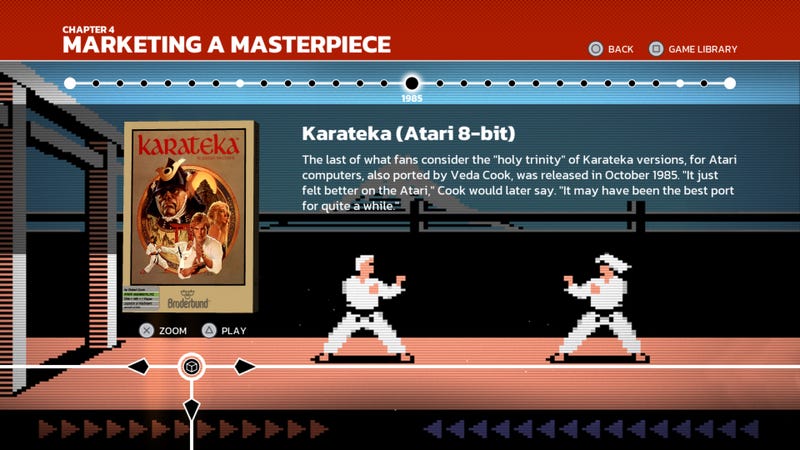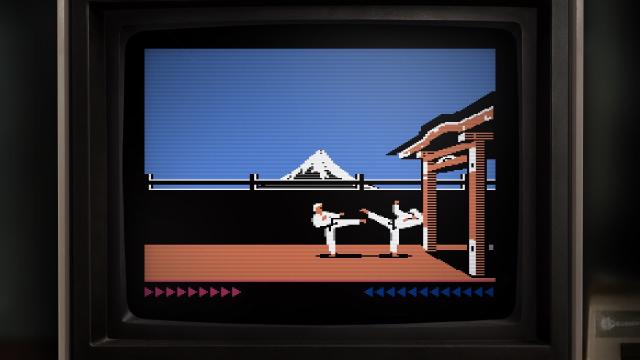When you first fire up The Making of Karateka, Digital Eclipse’s excellent interactive retrospective about Prince of Persia creator Jordan Mechner’s 1984 masterpiece, you’re greeted with this quote from his journals, written when he was just 18 years old:
“My goal for this summer is to finish Karateka. If it’s half as big as I dream it may be, that should be enough to launch me into the Video Game World.”
With this preface, The Making of Karateka makes its intentions crystal clear: not to dryly explain how a landmark game came to be, but to humanize that process of creation, capturing the creative brilliance and ambition of its young maker, without which Karateka never would have been made. Let me tell you why I think this matters so much.
Appreciating game history is as important as preserving it
When I was young, my mom, a movie lover, would sometimes show me films from the 1940s and ‘50s; films starring Cary Grant or Jimmy Stewart, films directed by Alfred Hitchcock or Billy Wilder. And, to be honest, I didn’t really get them. Being in black and white and dating from the vast irrelevance of time before I was born, they felt old and dusty to me. I couldn’t see them as the urgent, living creations that they are. I liked the lightsabers and starship battles of Star Wars, but didn’t yet grasp cinema as an art form that held onto its life and immediacy across the decades, an enduring reflection of the artistic impulses of those who made it.
Today, though, I can watch Citizen Kane and thrill to the innovations of Orson Welles, even though they’ve been imitated by a thousand filmmakers since. I can watch Evil Dead and be exhilarated by the ways in which director Sam Raimi pushed back against the low-budget technical limitations of that production to do remarkable, electrifying things.
And what opened the door for me is the fact that film history is not just preserved, but chronicled and celebrated, by filmmakers and critics and historians. I can watch Mark Cousins’ remarkable series The Story of Film; I can read reviews by influential critics like Pauline Kael and Andrew Sarris; I can listen to Martin Scorsese wax poetic about the films he grew up watching. Video games are still very young, but already, I fear we’re in danger—not of losing access to early games, but of losing the stories and perspectives that can illuminate what makes them so influential and exciting. I worry we’ll soon have legions of players who look at all the games made before the release of the NES in 1985 and simply think of them as irrelevant relics, like I once viewed those films of the ‘40s and ‘50s my mother showed me.
But it doesn’t need to be this way.
With The Making of Karateka, prestige emulation studio Digital Eclipse continues the work it’s done in earlier releases like last year’s Atari 50. The developers aren’t merely presenting us with a way to play old games; they’re offering a way into appreciating them, by telling the stories of their creation and by providing historical context that helps us recognize just how visionary and exciting they are, even if we aren’t old enough to remember the time in which they were released.
What is Karateka?
Karateka is a side-scrolling action game first released for the Apple II in 1984, and it’s remarkable. In concept, it’s so simple as to almost sound like the archetypal idea of a video game: you play as a young warrior who must fight through the forces of an evil warlord, infiltrate his castle, and rescue your beloved. Taking cues from classic martial arts movies like Enter the Dragon, Karateka has you face his cronies one by one, and although the combat is basic by today’s standards, it remains impactful thanks to its clean visual design and stylistic flairs like little impact explosions that show when either you or your opponent take damage. Today, we might say that it takes a kind of minimalist approach, communicating volumes through body language, a few striking camera shots, and a smartly deployed musical score, composed by Jordan’s father, Francis.
There’s also one extremely annoying bird.
Karateka remains supremely playable today. It’s a game that teaches you how to play it, a game whose exacting challenge makes it all the more rewarding to eventually emerge victorious. But I’m not naive. I know those who have no nostalgic connection to the original game will have a hard time seeing Karateka’s greatness. At this point, so many games have built on what Karateka does that it can be almost impossible to even recognize what it’s doing.
So it helps that The Making of Karateka illuminates all of that for us. Partially, this is done through interviews, not just with Mechner, and his father, and with people at Broderbund, the company which published the game, but with luminaries like id Software cofounder Tom Hall and Mortal Kombat co-creator John Tobias. Through their memories of playing Karateka in 1984 and their sense of its impact on the arc of game history, we can more clearly see what made it so remarkable at the time, and why it remains remarkable today.
I’ve always loved Karateka’s tight focus and its sense of drama, but playing it again, having watched the special features included here, gave me new appreciation for just how much Mechner was pushing the boundaries of what was possible at the time. For instance, the Apple II didn’t allow for scrolling in the traditional sense, the way we see it in, say, Super Mario Bros., but by using a remarkable optical trick, Mechner creates the illusion of scrolling.

And the animation—my god, the animation. A good chunk of The Making of Karateka goes toward chronicling the considerable effort Mechner put into the game’s movement, and rightfully so. Mechner used rotoscoping for this game, filming actual human beings in motion and basing the game’s animation on the living example he’d captured, and the results are extraordinary. Equally marvelous is that so much of that original material still exists, and that Digital Eclipse was able to include it here, demonstrating in detail how one of the most impressive feats in early game history was accomplished.
Capturing the creative impulse behind a video game masterpiece
It’s those volumes of archival material that let The Making of Karateka tell its story in a way that captures the creative fire burning inside Mechner. There’s that journal of Mechner’s that opens the game, of course, but we get glimpses into his lows as well as his highs, his struggles and the toll his creative focus was taking on him.
“I’m psyched for Karateka. Fuck [Mechner’s earlier, rejected game project] Deathbounce. What a waste,” he wrote on July 18, 1983. On February 6 of that year, he’d written, “When I’m working, time is so precious, I begrudge every minute I spend away from whatever-it-is I’m working on: Deathbounce at Christmas, Karateka now. I forget to sleep, to eat, to change clothes. My life gets all fucked up around me through sheer neglect.” He was consumed by his vision, and in this case, the obsession paid off, for him and for the medium of video games.
Contextualized by all this material—the interviews and audio commentaries, the back-and-forths about advertising copy and the fan letter from a young John Romero—we can’t help but see Karateka as not just a game, but a product of brilliant, human creation. We see how Jordan Mechner, as a teenage wunderkind, saw possibilities in the Apple II that others at the time simply didn’t see, or at least didn’t have the ingenuity and determination to capitalize on. In this era when AI is becoming a greater existential threat to human creativity on multiple fronts, a game like this, which puts that creativity front and center, feels all the more essential.
I hope that, even if only for five or ten people out there, The Making of Karateka opens up whole new realms of appreciation, perhaps helping them see so many games of the early 1980s in a new light, or encouraging them to recognize that certain games whose greatness they’d always taken for granted are worth appreciating for the creative vision and ingenuity on display.
Cinema benefits from entire ecosystems devoted to not just preserving its history but illuminating it and celebrating it. We see it in the essays that accompany every Criterion Collection release, in the copious special features on my old Lord of the Rings DVDs, in the revival screenings that happen at art house theaters across the country. These are the things that keep the real love for cinema alive, and that allow young people to access the world of filmmaking as more than just mainstream entertainment, but as a living, evolving art form. Games deserve and demand such things as well. The Making of Karateka is the first of Digital Eclipse’s Gold Master series. I very much hope it’s not the last.

Leave a Reply